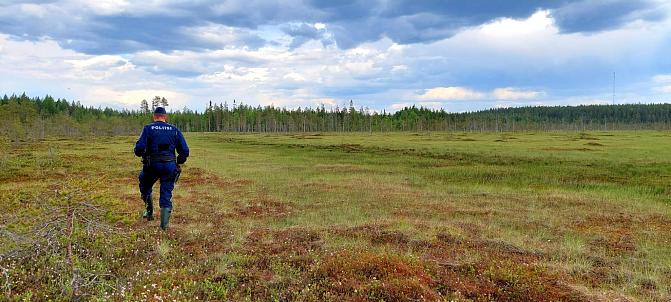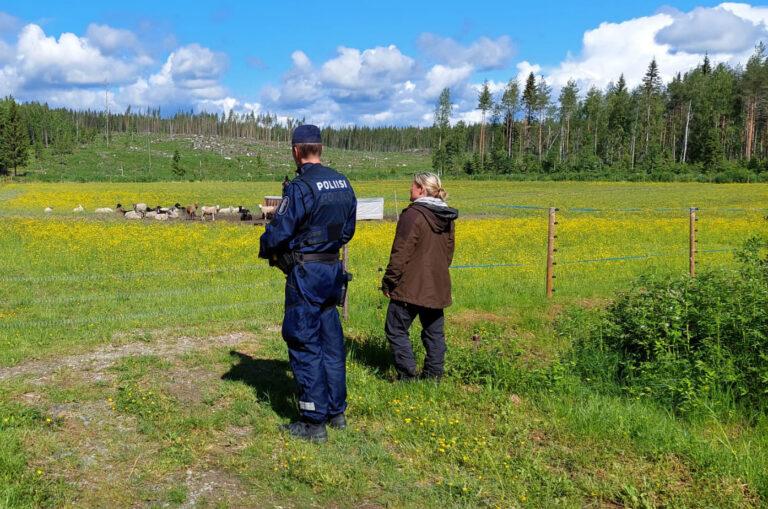The second year of the LIFE BOREALWOLF patrol
The second full year of the LIFE BOREALWOLF project is now behind us. From the perspective of the LIFE BOREALWOLF patrol, 2021 was generally a highly multifaceted and varied year. The patrol’s working and operating models were further developed and modified to support the performance of project tasks.

The patrol’s key tasks in the project are:
- Diverse cooperation and interaction with different stakeholders and citizens, for example, by giving instructions and advice, and by providing consultation with a low threshold to reduce, minimise and eliminate any conflicts. Activities aim to tackle any negative impact caused by wolves, such as fear, concern and anger, as well as frustration with the authorities.
- Carrying out diverse general monitoring activities, particularly in sparsely populated areas, including road and off-road traffic.
- Carrying out targeted official monitoring in areas where any illegal killing of large carnivores has previously been detected.
- Taking care of any conflicts resulting from large carnivores in cooperation with different regional game management parties (wildlife agencies, game management associations, contact persons for large carnivores and parties providing official assistance).
- Communicating and conveying correct information (social media, different exhibitions and events).
In general monitoring, the focus has been on hunting, primarily targeting hunting licences, the possession of weapons, hunting methods used in conjunction with licensed hunting, including the hunting of small game, and the carrying of weapons in vehicles. In late autumn, the monitoring focused on licensed elk hunting. In traffic control, the focus has been on driving while intoxicated.
The targeted monitoring has focused particularly on areas in which wolves are known to move. With the targeted monitoring, the law enforcement authorities aim to prevent, uncover and combat serious illegal hunting, aimed particularly at large carnivores.
All in all, the monitoring work has been focused on the region of North Karelia, but also that of Northern Savonia.
On 25 January 2022, the Eastern Finland Police Department published a release saying that it was investigating two suspected cases of illegal hunting (in Finnish only). The LIFE BOREALWOLF patrol is also involved in these investigations. In accordance with the Criminal Investigation Act, the provision of information is taken care of by the head investigators, due to which LIFE BOREALWOLF is not providing any comments on the cases at this time.
Other monitoring work and official collaboration
The patrol mainly carried out monitoring activities on its own, but also systematically on several occasions throughout the year with other authorities (Metsähallitus, the Eastern Finland Police Department and the Finnish Border Guard). This allows us to further develop collaboration between different agencies, especially in exposing and combating serious illegal hunting.
In sparsely populated areas, the monitoring carried out by the LIFE BOREALWOLF patrol also implements the obligation of ensuring the safety and security of sparsely populated areas in line with the Government Programme (Publications of the Ministry of the Interior 2020:15). The programme emphasises the importance of the authorities’ presence and visibility in areas with the weakest level of services. In addition to the objectives mentioned above, the activities influence the response times in urgent emergency calls. During the year, the patrol responded to some 20 emergency calls of various nature in sparsely populated areas.
Key indicators
The patrol’s activities are followed using a separate follow-up system. The following shows some key indicators related to the monitoring collected between 1 January and 31 December 2021:
- Vehicles inspected during monitoring activities 315
- Hunting and firearms licences inspected during monitoring activities 233
- Offences and misdemeanours uncovered in connection to monitoring activities 44
- Inspections at production holdings, etc. 22
The follow-up system also covers a number of other activities, such as participation in the collection of observation data (DNA), official collaboration and communication.
Management of foothold-trap tasks
In late summer 2021, the Eastern Finland Police Department was tasked with three different animal-related situations in which a foothold trap intended for smaller animals had snapped on the foot of a bear. Two of these three bears also had cubs with them. One of the bear mothers had four cubs, all less than a year old. The two cubs of the other bear mother were weaned cubs in their second year. The “Eno quintet”, in particular, kept the Eastern Finland Police Department and its partners busy, even outside the media show involved.
There were two attempts to catch the mother bear, followed by the four cubs, alive. The first attempt involved a cylinder made specifically for the purpose and the second lying in wait in a hut. Given that neither of these attempts was successful, the mother bear was not caught and the foothold trap could not be removed.
The LIFE BOREALWOLF patrol played a key role in these operations. A significant portion of its working hours in September and October were allocated to these “bear missions”. The patrol planned and carried out the attempts to capture the mother bear of the “Eno quintet” in cooperation with the other authorities. Although the attempts to capture the injured animal were ultimately unsuccessful before its hibernation (withdrawal to a winter den), the official collaboration yielded plenty of experience that is likely to prove valuable in the future.
The numerous shortcomings detected in the operating models, gear and equipment should be remedied before the spring of 2022. The police are also fairly likely to be faced with similar situations in the future elsewhere in Finland. The experiences gained from the foothold trap incidents were also used in the updating of the police’s national guidelines for situations involving large carnivores and wild boars (Poliisin toiminta suurpeto- ja villisikatilanteissa, POL-2020-6759). The new guidelines entered into force on 1 January 2022.
Conflict management and assisting citizens
Some of the patrol’s working hours during the year were allocated to the prevention of damage caused to domesticated and farmed animals by wolves. The first half of the year was especially busy on this front and a substantial portion of the working hours were spent in conflict resolution and prevention.
Early in the year wolves making repeated visits to the yards of human habitations in the region of North Karelia raised concerns and posed a danger to the region’s residents and their pets and farmed animals. Because of this, the Finnish Wildlife Agency and the Eastern Finland Police Department issued orders to drive off or put down a few individual wolves which had been causing problems. The patrol participated in the planning and operational implementation of these banishment and killing tasks, and their monitoring, among other things, so that they were carried out in compliance with the instructions and orders given by the licensing authority.
The second half of the year was a lot more peaceful in terms of any conflicts.
The topics under which local people are met over a year change according to the seasons. In the snowy months, wolves visiting yards keep the patrol busy, while in the summer, the work often involves inspecting damage caused by wolves. In these cases, the patrol is sometimes met by the shaken owner of a pet or farmed animal. In most cases, though, the reception at the farms has been very neutral.
Calls made by citizens in relation to different conflict situations are expected to increase. Residents in the operating environment have noticed that the patrol and other operators in the project are able to help them in many ways.
Social media was used to provide citizens with information on what yard visits and a tended yard area mean. The materials were distributed on the project’s various social media platforms and on the Facebook pages of the Eastern Finland Police Department, for example.
Stakeholder cooperation
Stakeholder cooperation was largely suspended due to the coronavirus pandemic. It is not likely to restart until the coming spring (2022), when risks related to the pandemic will be significantly reduced. The need for stakeholder cooperation is still considerable. A number of stakeholders have requested the patrol to get in touch with them.
In conclusion
All in all, 2021 was a busy year for the patrol, which had a sufficient amount of work to do, at the very least. The patrol’s activities have improved and developed the ability of the Eastern Finland Police Department to manage a variety of tasks involving large carnivores and combat serious illegal hunting. In this task we were assisted by a great number of different authorities and private citizens. The project will soon reach its halfway point, due to which we should start setting our sights on the future and thinking about how to take care of these tasks in Eastern Finland as of the beginning of 2025. While the job will be challenging, to say the least, the work has already begun. We will tell you more about our development measures in future reports and messages.
Harri-Pekka Pohjolainen
Superintendent
Eastern Finland Police Department
Juha Ahonen
Senior Advisor
Metsähallitus
Photos: © Tobias Peura & Kimmo Örn / SusiLIFE





